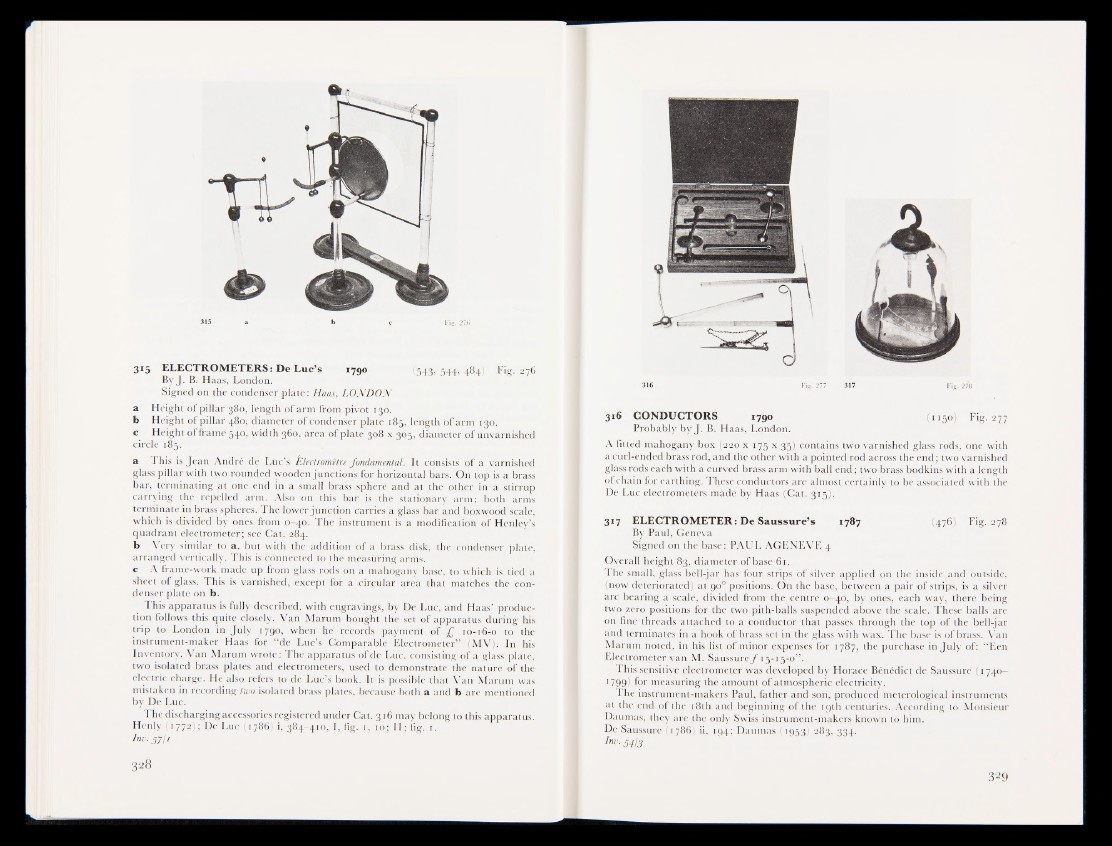
3*5 ELECTROMETERS: De Luc’s 1790 -1543, 544,484) Figfjfe®
ByJ. B. Haas, London.
Signed on the condenser plate: Haas, LONDON
a Height of pillar 380, length of arm from pivot 130.
b Height of pillar 480, diameter of condenser plate 185, length of arm 130.
c Height of frame 540, width 360, area of plate 308 x 305, diameter of unvarnished
circle 185.
a This is Jean André de Luc’s Electromètre fondamental. It consists of a varnished
glass pillar with two rounded wooden junctions for horizontal bars. On to.mis a brass
bar, terminating at one end in a small brass sphere and at the other in a stirrup
carrying the repelled arm. Also on this bar is the stationary arm ;/jfcolJt arms
terminate in brass spheres. The lower junction carries a glass bar and boxwood scale,
which is divided by ones from '6 40. The instrument is a modification of Henley’s
quadrant electrometer; see Cat. 284.
b Very similar to a, but with the addition of a brass disk, the condenser plate,
arranged vertically. This is connected to the measuring arms.
c A frame-work made up from glass rods on a mahogany base, to which is tied a
sheet of glass. This is varnished, except for a circular area that matches the condenser
plate on b.
This apparatus is fully described, with engravings, by De Luc, and Haas’ production
follows this quite closely. Van Marum bought the set of apparatus during his
trip to London in July 1790, when he records payment of £ 10-16-0 to the
instrument-maker Haas for “de Luc’|&Comparable Electrometer’ MV). In his
Inventory, Van Marum wrote: The apparatus of de Luc, consisting of a glass plate,
two isolated brass plates and electrometers, used to demonstrate the nature of the
electric charge. He also refers to de Luc’s book. It is possible that Van Marum was
mistaken in recording two isolated brass plates, because both a and b are mentioned
by De Luc.
The discharging accessories registered under Cat. 316 may belong to this apparatus,
Henly (1772); De Luc (1786) i, 384 410. I, fig. 1, 10; II; fig. 1.
Inv. jy/i
316 Fig. 277 317 Fig. 2-7S
316 CONDUCTORS 1790 (1150) Fig. 277
Probably by J. B. Haas, London.
A fitted mahogany box (220 x 175 x 35) contains two varnished glass rods, one with
a curl-ended brass rod, and the other with a pointed rod across the end; two varnished
glass rods each with a curved brass arm with ball end; two brass bodkins with a length
of chain for earthing. These conductors are almost certainly to be associated with the
De Luc electrometers made by Haas (Cat. 315).
317 ELECTROMETER: De Saussure’s *787 (476) Fig. 278
By Paul, Geneva
Signed on the base: PAUL AGENEVE 4
Overall height 83, diameter of base 61.
The small, -glass bell-jar has four strips of silver applied on the inside and outside,
(now deteriorated) at 900 positions. On the base, between a pair of strips, is a silver
arc bearing a scale, divided from the centre 0-40, by ones, each way, there being
two zero positions for the two pith-balls suspended above the scale. These balls are
on fine threads attached to a conductor that passes through the top of the bell-jar
and terminates in a hook of brass set in the glass with wax. The base is of brass. Van
Marum noted, in his list of minor expenses for 1787, the purchase in July of: “Een
Electrometer van M. Saussure ƒ 15-15-0” .
This sensitive electrometer was developed by Horace Benedict de Saussure (1740—
*799) for measuring the amount of atmospheric electricity.
The instrument-makers Paul, father and son, produced meterological instruments
at the end of the 18th and beginning of the igth centuries. According to Monsieur
Daumas, they are the only Swiss instrument-makers known to him.
De Saussure (1786) ii, 194; Daumas (1953) 283, 334.
H 54l3